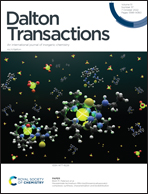Induction and rationalization of supramolecular chirality in a highly flexible Zn(ii)porphyrin dimer: structural, spectroscopic and theoretical investigations†
Abstract
A highly flexible pyrrole-bridged Zn(II)porphyrin dimer has been successfully utilized as an efficient host which enables an accurate determination of the absolute configuration directly for a large number of chiral amino alcohols and 1,2-diols. The addition of substrates resulted in the formation of 1 : 1 sandwich complexes which, after the addition of excess substrates, produced 1 : 2 host–guest complexes. In principle, the 1 : 2 host–guest complexes can be stabilized in three possible conformations, viz. exo–exo, exo–endo, and endo–endo based on how a substrate binds to the metal. The endo–endo conformation is stabilized by two strong interligand H-bonds [O–H⋯O(H)] between encapsulated diols which thereby interlock the stereochemistry. In the absence of such interligand H-bonding interactions, exo–endo binding is preferred as it is indeed observed for amino alcohols which show weaker CD couplets due to the free movement of substrates. The sandwich complexes with amino alcohols show a more intense CD couplet compared to the diols due to the stronger binding of the amine functionality (–NH2) towards a Zn-atom over an alcoholic moiety (–OH). The CD amplitude showed linear dependence with a binding constant for the 1 : 1 sandwich complex upon varying the substrates. Spectroscopic investigations, single crystal X-ray structure determination of four such host–guest complexes and DFT studies have enabled us to rationalize systematically the origin of optical activity unambiguously in the 1 : 1 and 1 : 2 host–guest complexes, which lead to an absolute stereochemical determination of a large number of chiral substrates. The larger vertical and horizontal flexibility of a diethyl pyrrole spacer induces stronger binding of the substrates to form the 1 : 1 complex with a much larger torsional angle along with intense CD couplets. In contrast, a rigid dibenzothiophene-bridged tweezer, due to its limited horizontal and vertical flexibility, facilitates 1 : 2 complexation more as compared to the highly flexible pyrrole-bridged host which results in stronger binding of the substrate with the intense CD couplet for the former.



 Please wait while we load your content...
Please wait while we load your content...